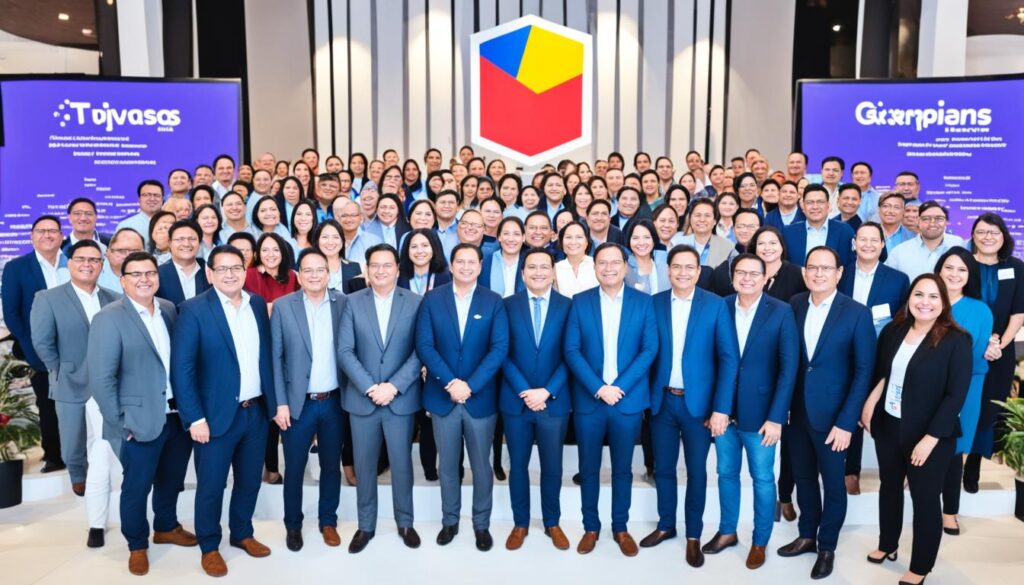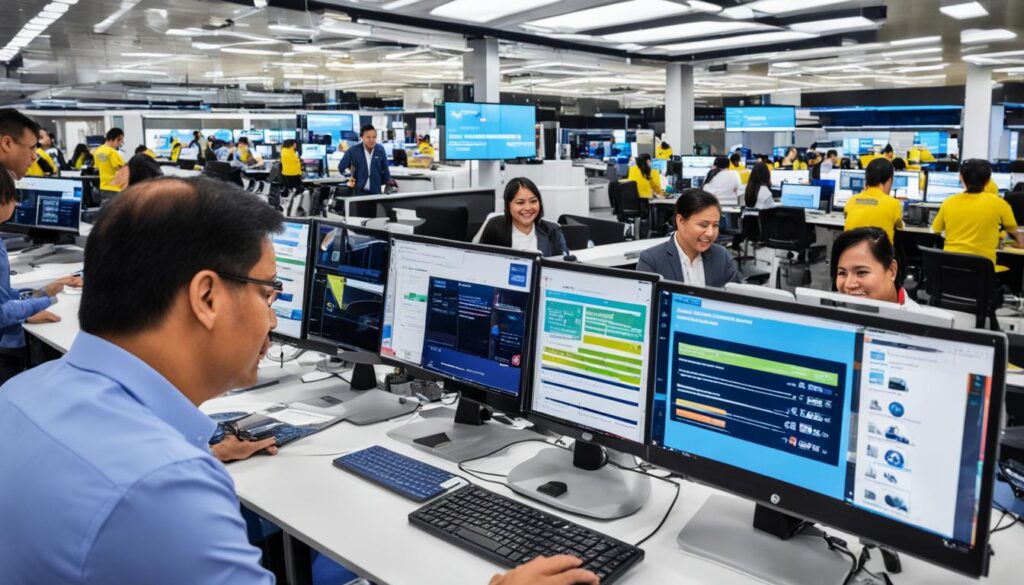The world is quickly moving into the digital era. Businesses are changing to keep up and meet customers’ needs. In the Philippines, we see these changes too. Let’s look at some successful digital transformation stories from here.
In the Philippines, many organizations are turning to technology to change how they work. We will discuss these real-life stories. They show how different businesses are using tech to make big improvements.
These changes are happening from small companies to big ones. The Philippines’ digital transformation scene is full of success stories. They highlight the benefits of using technology to innovate in business.
Let’s start by looking at one big success story of digital transformation:
Their changes made shopping more personal and seamless for customers. They also became more efficient in managing supplies and analyzing data for decisions. This lead to a better market position and retail experience for their clients.
We will explore more about digital transformation in the Philippines. We will see what worked and what we can learn from these stories. So, come with us as we discover digital transformation success in the Philippines!
Key Takeaways:
- Digital transformation is rapidly reshaping businesses in the Philippines.
- Successful digital transformation examples demonstrate the power of technology in enhancing customer experiences and improving operational efficiency.
- By embracing digital innovation, organizations can gain a competitive edge in the ever-changing business landscape.
- Throughout this section, we will explore more inspiring case studies of digital transformation in the Philippines.
The Rise of E-commerce and Digital Consumer Engagement
In the Philippines, e-commerce and online consumer involvement have seen remarkable growth. Technology and easy internet access have changed how Filipinos do business and interact with brands. This part explores the key elements fueling this trend, such as the fast growth of online sales, changes in Filipino buying habits after the pandemic, and where these e-commerce activities happen.
Stellar Sales Growth in the Philippine E-commerce Sector
The e-commerce scene in the Philippines is growing quickly. More people are using the internet and smartphones, and online payments are easier. In (mention the year), e-commerce sales grew by (specific data or percentage), hitting record numbers. This rise shows how important e-commerce is for the economy and how people’s preferences are changing.
Shift in Filipino Consumer Behavior Post-Pandemic
The COVID-19 pandemic sped up the move to online shopping for Filipinos. Lockdowns and distancing rules put in-person shopping on pause, pushing people towards online stores. This change spiked online sales and made Filipinos more open to e-commerce. They now enjoy the safety, convenience, and range of products online platforms offer.
Geographical Distribution of E-commerce Transactions
E-commerce in the Philippines reaches beyond just big cities. Although a large amount of online buying happens in Metro Manila, other places are catching up. More people in the provinces are now using e-commerce. This means businesses have more chances to grow and reach new customers.
The image above highlights how online shopping has spread across the Philippines. It offers new possibilities and some hurdles for businesses. They need to understand this changing digital world to meet the needs of their online Filipino customers.
Digital Transformation Strategies Among Filipino Businesses
In today’s fast-changing digital world, Philippine businesses see how important it is to keep pace. They’re working hard on digital transformation to stay ahead and meet new customer needs. Digital transformation is not just important; it is key for success in the modern world.

Adoption of Digital Marketing in Online Businesses
Successful digital transformation often includes digital marketing. Businesses in the Philippines are using these tools to reach more people. They are aiming to increase website visits and boost sales.
Digital marketing lets businesses connect with their audience in personal ways. This includes using social media, SEO, content, and email marketing. Such efforts help businesses offer relatable content, improve their online visibility, and foster customer loyalty.
By looking at data and analytics, businesses can see what works in their digital marketing. This information helps them make smarter decisions, improving their strategies over time.
Incomplete Digital Transformation Strategies in Philippine Organizations
Digital transformation’s full adoption has not been easy for many in the Philippines. Challenges interfere with going completely digital. Some companies have started but not fully finished their digital transformation.
Reasons for this can be the lack of resources, knowledge among staff, and fear of change. A full digital strategy is also often missing. Without a solid plan, businesses might not get all the benefits of digital technologies.
It’s worthwhile for companies to put digital transformation high on their to-do list. They should invest in training and new resources. Working with experts in digital transformation can also make a big difference in this journey.
Overcoming these challenges presents real opportunities for businesses in the Philippines. They can run more efficiently, offer better customer service, and get in front of the competition in the digital realm.
Key Elements of Digital Transformation in Philippine Companies
Businesses in the Philippines are changing fast in the digital world. To thrive, they are focusing on customer engagement, offering personalized experiences, empowering employees, and optimizing operations through data analysis.
Customer Engagement: A Personalized Experience
Today, engaging customers is key to a business’s success. Companies use digital tools to create experiences that customers love. They analyze data to understand what customers want, helping them tailor their products and marketing. This personal touch boosts customer satisfaction and loyalty, driving business growth.
Employee Empowerment Through Digital Tools
Digital tools are also enhancing how employees work. Companies are giving their teams tools that make work easier and more efficient. Workers can communicate better, manage projects, and automate tasks, leading to more effective and innovative teams. This empowerment leads to better company performance overall.
Operation Optimization via Real-Time Data Analysis
Real-time data analysis is changing how businesses work. It allows companies to track and improve their activities as they happen. With this approach, businesses make informed decisions quickly based on the latest insights. This applies to everything from managing supplies to understanding customer needs. The goal is to get rid of inefficiencies, cut costs, and perform better overall.
As the digital change in the Philippines speeds up, focusing on customers, employee empowerment, and smart operations is crucial. These steps help companies not just keep up but lead in the digital market.
The Vital Role of MSMEs in the Philippines’ Digital Innovation
Micro, Small, and Medium-sized Enterprises (MSMEs) are key in the Philippines’ digital push. They change traditional businesses by using digital tech. This helps the economy grow and improves many industries.
Budgetary Constraints for MSMEs
MSMEs often struggle with limited money when going digital. This makes it hard to buy new tech, hire experts, or start digital projects. Big companies can spend more, giving them an edge.
Technological Challenges for MSMEs
Using new digital tools can be tough for MSMEs. They may not have the right tech knowledge or the needed systems. It’s hard for them to connect new tech with their old ways of working.
And, keeping up with tech changes is a constant challenge. Without clear guidance, it’s not easy for MSMEs to pick the best tech for their needs.

Yet, MSMEs are not giving up. They find ways to beat these problems and lead in digital changes. Their quickness and creativity help them find solutions to money and tech issues.
Help from the government and partnerships can be game-changers. Programs that offer money and trainings can lift MSMEs up. Working with tech and business pros can also open doors to new skills and advice.
Diving into digital upgrades can make MSMEs stronger. They can run more smoothly, connect with more customers, and grow. With digital, they can also spot new opportunities, like e-commerce, and succeed online.
| Challenges | Solutions |
|---|---|
| Budgetary Constraints | Government funding programs Partnerships with larger organizations Access to financing options for digital initiatives |
| Technological Challenges | Collaboration with technology providers Digital skills training Infrastructure development |
In the end, MSMEs are vital for digital growth in the Philippines. Even with money and tech issues, they can lead with their smarts and teamwork. This drive can push them to win in the digital world.
Digital Transformation Trends Reshaping the Philippine Economy
Digital transformation is changing the world’s economies and the Philippines is part of this change. New technologies bring both new chances and challenges to the country’s economy.
We’ll look into some key trends reshaping the business scene in the Philippines. Businesses are using new tech and digital plans to innovate, be more productive, and enhance how they serve customers.
The Philippines is seeing more companies move to use cloud services. Using the cloud helps businesses work better, work together more, and cut costs. Cloud services allow companies to grow quickly, protect important data, and offer easy ways for people to get to work. This makes them more efficient and competitive.
Cloud computing has become a game-changer for businesses in the Philippines. It has allowed us to optimize our operations, simplify workflows, and respond quickly to market demands. The scalability and cost-effectiveness of cloud-based solutions have significantly contributed to our business growth.
There’s also a big jump in digital payments and buying things online. More people in the Philippines are using digital money and enjoying shopping online because of many available platforms. This change is boosting online business growth and creating chances for both local and foreign brands.
Another big change is using AI and data analytics in businesses. Companies are using AI and smart data tools to understand things better, make better choices, and connect with customers. They use data to track trends, personalize services, and create more focused marketing. This helps businesses make customers happier and earn more money.
To compete today, Philippine companies need to get on board with these digital trends. By using new technologies smartly and boosting innovation, they can find new opportunities for growth. This way, they help push the country’s economy forward in its digital transformation.
Digital Transformation Examples: Success Stories in the Philippines
In the Philippines, we see local companies using new technology to grow and innovate. They show us the big changes that happen when digital tools are used well.
IoT Integration in Local Enterprises
IoT, or the Internet of Things, is making change in the Philippines. It links devices to gather data in real time. This data helps companies run better and serve people more efficiently.
Smart Communications is using IoT to help build smart cities. By adding sensors to things like streetlights and trash bins, they can manage these things better. This brings savings and a nicer living environment for people.
Green Antz is using IoT to farm smarter. Their sensors study the crops, soil, and weather conditions. This helps them water plants just right, stop diseases, and grow more food. This makes farming more efficient and earth-friendly.
These examples show us how IoT is changing local businesses. By using smart devices and data well, companies can work better, please customers, and grow in a way that’s good for the planet.
The Emergence of AI and Machine Learning Applications
In the Philippines, AI and machine learning are also making a big impact. They’re changing the way businesses make decisions. This gives them new chances to do well and stand out.
Ayala is using AI to make talking to customers better. Their chatbots and voice systems provide quick and personal help. This has made their customers happier and more loyal.
Manulife uses AI to speed up how they check requests for insurance. This helps them make faster decisions and serve customers better. It has made customer services smoother and quicker.
AI and machine learning are helping businesses in the Philippines work smarter. They’re cutting down on boring tasks, making choices with data, and treating customers as individuals. These changes are pushing digital growth even more.

IoT, AI, and machine learning are changing how businesses in the Philippines work. They’re turning digital ideas into big wins. These stories are encouragement for all companies wanting to start their digital journey.
Impact of Mobile Technology on Digital Transformation
In today’s world, mobile technology is key in pushing digital changes. It has changed how companies work and how we shop. This section talks about mobile’s big role in online shopping, mobile banking, and moving to cashless.
Mobile Phones Driving E-commerce and E-banking
In the Philippines, mobile phones are now crucial for shopping and banking online. This is thanks to easy internet access. People can buy what they want anytime, anywhere. Online stores and banks have made mobile apps to make this even easier. This has boosted online sales a lot.
Mobile banking is changing how we do banking, too. Filipinos can do many bank things on their phones. This includes moving money, paying bills, and checking on their accounts. It’s a big help, especially for those far from banks.
The Shift Towards Cashless Transactions Amidst the Pandemic
The pandemic has pushed even more for cashless payments. It’s safer to use phones and not cash. Mobile apps and digital wallets are making this switch easier for everyone.
Going cashless is safer and makes payments quicker. It also helps businesses save money and learn more about their customers. These are all big wins.
Mobile tech is only going to get more important as we go on. Companies need to use it well to keep up with the digital world changing fast.
Government and Private Sector Collaboration in Digital Initiatives
Working together, the Philippine government and businesses drive the country’s digital growth. They join hands to use tech and new ideas for the good of all. We’ll look at how they boost small businesses’ access to digital tools and the role the government plays.
Partnerships Boosting MSME Digitalization
Small and medium-sized businesses are key to the Philippines. So, there are partnerships to help them go digital faster. These alliances aim to give small businesses what they need to succeed online.
The Department of Trade and Industry and tech leaders team up to help. They offer classes, advice, and low-cost tech solutions to these businesses. With these new skills and tools, small businesses can grow, serve customers better, and run more smoothly.
Also, groups from the government, business world, and associations come together. They create places where small businesses can learn and try out new tech and ideas. Here, small businesses can meet others and find help that speeds up their move to digital.
Government’s Role in Fostering a Digital Economy
Showing the way in building a digital economy is the government’s job. They set the stage and make rules that help digital ideas grow. The Department of Information and Communications Technology leads the charge on going digital.
Helping out goes beyond just giving things like internet access. It’s also about making fair rules for using the web. The government, with help from businesses, makes plans to keep data safe and the internet fair. This keeps businesses and people confident in the digital world.
The government also cheers on new businesses, especially in digital fields. They offer help to startups like funding and advice. This way, the Philippines gets more digital businesses off the ground.
Collaboration between the government and businesses is big for going digital in the Philippines. With efforts to help small businesses get digital and build a friendly digital space, the country can make the most of the digital age.

Emerging Technologies and Their Role in Digital Transformation
The digital world is changing fast. Thanks to new tech, industries are improving. This tech makes work better, makes customers happier, and cuts down on wasted time. In the Philippines, more companies are using new tech to keep up and grow. This move helps them stay ahead and prepare for what’s next.
AI is one big tech trend here. It lets businesses do things automatically, understand lots of information, and make smart choices. With AI, companies can treat customers in a special way. They can also work better and simpler. This sparks new ideas and ways to grow.
Blockchain is also making its mark in the Philippines. It makes deals more clear, safe, and trustworthy in finance, buying and selling goods, and health care. It cuts out the middleman and makes working together easy. This helps companies work smarter, spend less, and make sure their digital steps are safe.
Cloud computing is changing how companies store and use data. It offers space that can grow or shrink as needed. This makes working with others easier and gets to apps and services faster. Cloud tech makes companies able to move fast to meet new challenges.
These are just a start to how tech is changing the Philippines. Companies that use these tools do better than their rivals. They serve customers in new ways and always look for fresh ideas. But, bringing in new tech needs a clear plan and support. It means setting up right, training your team, and making the switch to digital ways without hiccups. Doing this right is the key to win with these new technologies.
Conclusion
This article showed how the Philippines is changing digitally. We learned how it affects both businesses and people. The boost in online shopping and new ways to connect with customers has really helped companies grow. The pandemic sped up the switch to digital ways. Now, more businesses are using the internet to reach consumers.
Companies in the Philippines are focusing on digital marketing to grow. But there’s still more they can do to use digital tools fully. Learning how to engage customers, empower workers, and use data to make decisions is key. These steps help businesses keep getting better.
Small and medium-sized businesses play a big part in the Philippines’ digital change. Even with limited money and tech challenges, they need to step into digital. The government and businesses working together help them. This support encourages these smaller businesses to go digital.
New tech, like IoT, AI, machine learning, and mobiles, are making the economy better. Phones are especially important, helping with online shopping and banking. The government’s support is important for more digital changes.
So, digital change is really happening in the Philippines. It’s changing how companies work and reach out to people. This article showed many chances for growth and new ways to do things because of digital change. With everyone’s effort, the Philippines can have a strong digital economy. This will help the country’s future be even better.
